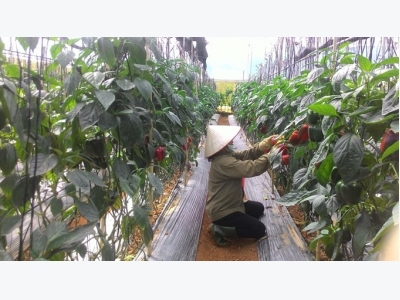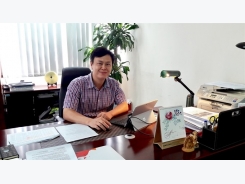Lâm Đồng farmers go high tech

Red chili garden of farmer Nguyễn Xuân Hội in Đà Lạt City. — VNS Photo Nguyễn Phúc Ban Thiên
LÂM ĐỒNG — The Central Highlands Province of Lâm Đồng is leading the country in high-tech agriculture. It grows crops on nearly 50,000ha under hi-tech agricultural methods. This amounts to 18 per cent of the province’s land under production.
According to the provincial Department of Agriculture and Rural Development, the high-quality vegetable production model yields VNĐ400 million to VNĐ500 million (US$17,400-21,700) per hectare each year. Flower production reaps up to VNĐ1.2 billion ($52,200) per hectare each year, while tea and coffee yield VNĐ250 million ($10,870) per hectare annually.
The record productivity is helped by high technology aqua culture and brings in VNĐ8 billion to VNĐ9 billion ($347,800-$391,300) per hectare a year.
The modern farming has set an example for other localities. However, the high-tech scene, especially small-scale models, faces several handicaps.
Nguyễn Xuân Hội is the owner of a 3,000 sq.m technology-based farm which cultivates flowers, mini cucumbers and chili in Đà Lạt City. Being aware that planting clean vegetables is the best way to protect the health of consumers, for years, he nurtured the desire to farm without using chemicals. However, it was not until a year ago that he obtained the financial resources to realise his dream.
He invested more than VNĐ1 billion ($43,500) on green houses, auto irrigation systems and imported chemical-free fertilisers, which he called “hi-tech agriculture”.
“The biggest difficulty when I started was raising VNĐ1 billion in capital. I had to borrow from a bank and apply for mortgage. The bank preferential interest rate is low at only 1.1 per cent,” he said.

Hà Đông flower village, the first of its kind in Đà Lạt City, Lâm Đồng Province. The village, which covers an area of about 390ha, has grown flowers in greenhouse, making high economic values of VND100-150 million (US$4,350-6,520) per 1,000 sq.m per year. — VNA/VNS Photo Nguyễn Dũng
Having more than 3,000sq.m of land, Trần Văn Phước, a farmer in Đạ Nghịch Village, Lát Commune, Lạc Dương District, decided to invest in a greenhouse. However, he could not borrow the VNĐ560million ($24,400) needed, as the loan limit was only VNĐ70 million without collateral.
Trần Văn Tần, deputy head of State Bank of Việt Nam’s Credit Department, said that lending for hi-tech agriculture involved a lot of risks and lacked agricultural insurance policies.
The investment capital for hi-tech agriculture projects is enormous. In fact, in Lâm Đồng Province, greenhouse investment is worth VNĐ1.3 to VNĐ3 billion ($56,500-130,400) per hectare. However, most of the products do not have stable markets, so investment efficiency remains limited, according to Tần.
Even hi-tech agriculture enterprises face challenges. According to the regulations, properties listed as high technology must be attached to land. However, green houses and net houses have not been granted property ownership rights on agricultural land, and so a limited number apply for mortgages.
The owners of small-scale high-tech farms, such as Hội, who receive little support from local authorities, are struggling to find markets. Hội must himself find companies to sell his products.
“I signed a contract with Cầu Đất Farm Company. Every week, they come to buy my plants, but the price is unstable,” he said.
“My farm is on agricultural land which lies in a forestry area. The path leading to my farm is so muddy that vehicles entering my farm can transport only two tonnes of vegetables and fruits at the most. This reduces production efficiency,” Hội said, adding that farmers like him hoped the local authorities would help them upgrade the road to facilitate their farming.

Invitro technology is used in tissue cultivation in Đà Lạt Flower Forest Company in Lâm Đồng Province. The province has 47 manufacturing facilities applying this technology. — VNA/VNS Photo Nguyễn Dũng
Fuel high tech
Nguyễn Văn Sơn, director of the provincial Department of Agriculture and Rural Development, said that the province had taken some land accumulation measures to support hi-tech farming.
After land clearance, the State acquires farmers’ lands, builds infrastructure on the land and then lends it to enterprises.
Another way is that enterprises implement their projects first. The local authorities will then approve the projects and assign land to domestic and foreign enterprises for rent within 20 to 50 years. Enterprises can even negotiate to purchase or hire farmers’ land. The State will support them with land compensation and land clearance.
The provincial authorities consider hi-tech agriculture as the key to develop the local economy and are always creating favourable conditions for this section, along with supportive policies from the Government.
According to the provincial Department of Agriculture and Rural Development, private farms and farming households play an important role in the development of local hi-tech agriculture, because these farms account for large production area and primary capital (86.2 per cent of area and 64.5 per cent of capital).
The province values the role of farmers and hopes to promote production and consumption by helping producers network with enterprises and co-operatives to stabilise markets, the department said.

Đà Lạt City and neighbouring zones will run a trial “green village” model. The policy will also waive the tax on imported equipment and materials, which Việt Nam is unable to manufacture, to build green houses and net houses.
In Lạc Dương District, a leading locality for hi-tech agriculture in Lâm Đồng Province, the district authorities, in collaboration with enterprises, have started training courses for farmers on farming techniques. This helps enterprises keep employees, farmers get jobs and learn effective means to produce on their own land. The farmers’ attitudes towards high-tech farming have changed, and they have reaped more profits.
Lâm Đồng Province’s authorities are also paying attention to technology advancement, a key aspect.
Võ Thị Hảo, director of the provincial Department of Science and Technology, said that 60 per cent of the province’s investment in science and technology was spent on promoting hi-tech agricultural application, such as seed selection and producing seedlings.
“The state management’s role and research roles of the departments have been separated. The research is assigned to institutes and educational facilities. The provincial agencies ask these institutes and facilities to conduct the research, and then apply them in practice,” she said.
“By doing this, we can connect research with local practice, as well as encourage management agencies to use the research results.”
Related news
Tools

Phối trộn thức ăn chăn nuôi

Pha dung dịch thủy canh

Định mức cho tôm ăn

Phối trộn phân bón NPK

Xác định tỷ lệ tôm sống

Chuyển đổi đơn vị phân bón

Xác định công suất sục khí

Chuyển đổi đơn vị tôm

Tính diện tích nhà kính

Tính thể tích ao




 Việt Nam hi-tech farming needs systemic development
Việt Nam hi-tech farming needs systemic development  Hi-tech farms offer a vision of the future,…
Hi-tech farms offer a vision of the future,…